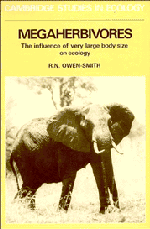Book contents
- Frontmatter
- Contents
- Preface
- 1 Prologue
- 2 Morphology, evolutionary history and recent distribution
- 3 Food and other habitat resources
- 4 Space–time patterns of habitat use
- 5 Body size and nutritional physiology
- 6 Body size and feeding ecology
- 7 Social organization and behavior
- 8 Life history
- 9 Body size and sociobiology
- 10 Body size and reproductive patterns
- 11 Demography
- 12 Community interactions
- 13 Body size and population regulation
- 14 Body size and ecosystem processes
- 15 Late Pleistocene extinctions
- 16 Conservation
- 17 Epilogue: the megaherbivore syndrome
- Appendixes
- References
- Index
10 - Body size and reproductive patterns
Published online by Cambridge University Press: 01 June 2011
- Frontmatter
- Contents
- Preface
- 1 Prologue
- 2 Morphology, evolutionary history and recent distribution
- 3 Food and other habitat resources
- 4 Space–time patterns of habitat use
- 5 Body size and nutritional physiology
- 6 Body size and feeding ecology
- 7 Social organization and behavior
- 8 Life history
- 9 Body size and sociobiology
- 10 Body size and reproductive patterns
- 11 Demography
- 12 Community interactions
- 13 Body size and population regulation
- 14 Body size and ecosystem processes
- 15 Late Pleistocene extinctions
- 16 Conservation
- 17 Epilogue: the megaherbivore syndrome
- Appendixes
- References
- Index
Summary
Introduction
Much attention has been devoted by ecological theorists to patterns of variability among life history parameters. These not only influence rates of population increase, but are the features most directly associated with genetic fitness. Hence they are likely to be subject to strong natural selection in relation to the ecological conditions prevailing for the species.
A key concept is that of r- and K-selection (MacArthur & Wilson, 1967; Pianka 1970; Horn 1978). These labels are derived from the logistic equation of population growth: r represents the potential rate of population increase, K the equilibrium density or carrying capacity attained by the population. In unstable environments populations are likely to spend much of the time in phases of population increase following catastrophic reductions in density. Under these conditions density dependent factors exert relatively little influence, and the most successful phenotypes should be those which can multiply their descendants at the greatest rate during the increase phase. Such circumstances favor rapid reproduction, i.e. short breeding intervals, large litters and quick growth to maturity. In contrast, in more stable environments populations remain close to carrying capacity for most of the time. In such circumstances intraspecific competition for limiting resources is strong, and the most successful individuals are likely to be those capable of using these limiting resources efficiently towards maintaining a high population density. Selection should favor greater longevity, slower breeding rates and more parental care.
- Type
- Chapter
- Information
- MegaherbivoresThe Influence of Very Large Body Size on Ecology, pp. 181 - 199Publisher: Cambridge University PressPrint publication year: 1988
- 1
- Cited by



